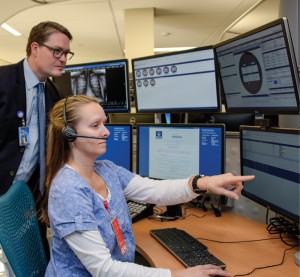At a high-tech operations center in the Taylor Pavilion on the Westchester Medical Center campus, intensive care nurses this fall are monitoring patients”™ health from a distance at new workstations.
A registered nurse ”” an eICU nurse newly trained for work in the Westchester Medical Center Health Network”™s Telehealth Center that began operating in October ”” sits in front of an array of eight computer monitors. One screen shows a patient”™s chest X-ray; another tracks the conditions of patients”™ organs with simple screen orbs whose eight segments each represent an organ. Red dots indicate a more seriously diseased organ and the dots enlarge according to the severity of the patient”™s illness. Medications, blood test results, respiratory rates and other information are sent to the operations center through secure, high-speed data lines from bedside monitors.

- Dr. Corey Scurlock and intensive care nurse Lisa Lapolla check patient information at a high-tech workstation in the new Telehealth Center at Westchester Medical Center in Valhalla.
Two-way video cameras and microphones installed in several adult intensive care units on the Valhalla campus enable eICU nurses to watch patients and talk with bedside nurses, doctors and family members in the distant units.
Working in 12-hour shifts, each nurse in the 5,000-square-foot operations center of WMCHealth”™s new eHealth program can monitor 30 to 35 patients at a time, said Kathy Longo, senior director of nursing for ICU. She said three shift nurses monitor about 88 beds.
For the hands-on doctors and nurses attending patients, “They”™re like a second set of eyes,” Longo said of the TeleHealth Center”™s small crew. A physician will be added for each shift in January, when the telehealth technology is fully launched in ICUs on the Valhalla campus and at MidHudson Regional Hospital in Poughkeepsie, the former St. Francis Hospital acquired out of bankruptcy in 2014 by Westchester Medical Center.
“It”™s a second set of eyes and information can be more streamlined,” said Longo, who has overseen the training of 400 intensive care nurses at both ends of the telehealth system. “Processes can be shortened, still maintaining quality” of care.
Dr. Corey Scurlock joined WMCHealth this year as medical director of its Telehealth Center, having previously served as national medical director of Advanced ICU Care in St. Louis. He said the use of remote technology in intensive care began about 15 years ago to counter a shortage of ICU nurses and doctors, especially in more medically underserved rural areas. As the nation”™s Baby Boomer generation ages into their 60s, 70s and 80s, intensive care units are expected to see significantly higher use, he said.
“It started out as a solution for a shortage,” but the technology has wider applications, Scurlock said. It can, for example, alert medical staff to trends in patients”™ conditions that might lead to infections, heart attacks or strokes.
Beyond intensive care, telehealth technology can serve “really the whole gamut of any kind of medical field,” he said.
The Telehealth Center director said WMCHealth plans to add stroke patient monitoring across its Hudson Valley network. The technology ”” much of which comes from Royal Philips Electronics NV, the Dutch health care and technology company that this year entered into a 15-year, $500 million business partnership with Westchester Medical Center ”” can get people with acute strokes “optimal care at a distance,” he said.
WMCHealth also has begun remotely monitoring cancer patients at the MidHudson Regional Hospital infusion center in Poughkeepsie, Scurlock said. “We see it reaching about every (medical) field the next two years,” he said.
Hospital officials said WMCHealth initially invested $7 million in technology, infrastructure, staff and additional resources to launch the telehealth program. It is the first of its kind based in the Hudson Valley and serving Hudson Valley residents, they said. In the metropolitan area, only North Shore-LIJ Health System operates a telehealth center, which is limited to North Shore”™s Long Island facilities, Scurlock said.
Telemedicine”™s efficacy in intensive care units has been reported in the Journal of the American Medical Association. In a 2011 study of about 6,000 patients in the University of Massachusetts health care system, Scurlock said, incorporating telehealth monitoring in ICUs decreased patient deaths by 20 percent and reduced the length of hospital stay by 26 percent.
In Poughkeepsie, WMCHealth”™s new system is already being used in an ePsychiatry program that connects behavioral health outpatients and staff at MidHudson Regional Hospital with clinical psychiatric physicians at WMC”™s Behavioral Health Center in Valhalla. “It has shown remarkable improvement in scheduling,” with patents keeping their appointments at a much higher rate, Scurlock said.
Though it is a telehealth pioneer in the Hudson Valley, WMCHealth is joining an established nationwide trend in medical care, as more than 50 health systems and 400 hospitals operate successful telehealth programs, according to WMC officials.
“The teleICU is not meant to be a replacement for the doctor or nurse at the bedside,” Scurlock said. “It”™s really a supplement.”
Scurlock said telehealth technology tends to be most useful to hospitals during off-hours on nights and weekends, when fewer nurses and doctors are on duty. That second set of screen-monitoring eyes can help reduce stress levels for on-site doctors and nurses, he said. The technology also enables highly centralized, consistent care, he said.
WMCHealth President and CEO Michael Israel, in an announcement of the Telehealth Center”™s recent opening, said the study of Massachusetts intensive care units showed “an outcome that is certainly worth the investment we are making in eHealth. With seven hospitals and dozens of health-related entities across 6,200 square miles, supported by a workforce of 10,000 dedicated professionals, eHealth will extend our expertise further into the communities we serve, delivering on our commitment to provide the best care as close to home as possible to the residents of the Hudson Valley.”















